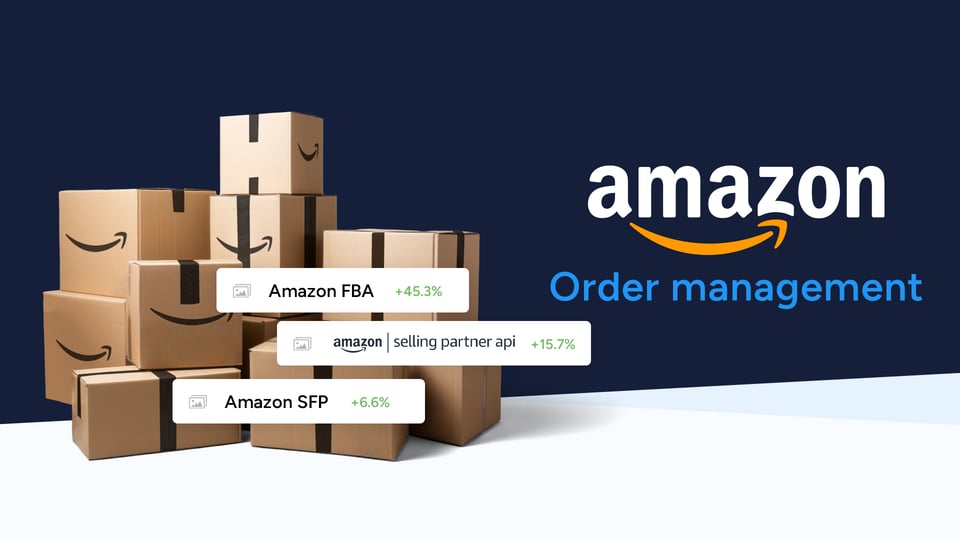With $1.4 billion in daily sales, Amazon is the go-to platform for ecommerce sellers looking to diversify their sales channels beyond traditional websites or physical stores.
However, if you want to thrive on the vast Amazon marketplace, whether you are a small business owner or an ecommerce veteran, it is imperative to have a robust strategy for managing your orders.
An order management system serves as the backbone of the ordering and fulfillment journey. It helps to ensure a seamless customer journey that promotes brand loyalty, consumer trust, operational efficiency, and continuous revenue streams.
In this article, we will help you understand what Amazon order management is, the types of Amazon automation software tools available, and why it is important for successful ecommerce.
What is Amazon order management?
On Amazon, order management involves overseeing the entire customer order process, from the point of sale to the final delivery. This process is crucial for achieving customer satisfaction, operational efficiency, and overall business success.
While Amazon has its own tools for managing orders, merchants (especially with large volumes or multiple sales channels) often opt for specialized automation software. We will discuss these later in the article, but below are the six core stages of Amazon order management.
1. Order placement
Customers browse Amazon's website or app, select their required products, and then advance to checkout. The confirmed order is entered into the order management system.
2. Order processing
Following placement, the order is routed to the seller's Amazon Seller Central account. Sellers receive notifications of new orders and begin processing, which involves confirming inventory, prepping products for shipment, and creating shipping labels.
3. Fulfilment
Sellers can select between Fulfilment by Amazon (FBA) and Seller Fulfilled Prime (SFP) for order fulfillment. FBA delegates storage, packing, and shipment to Amazon's fulfillment centers. In contrast, SFP requires vendors to manage their own fulfillment while conforming to Amazon Prime delivery prerequisites.
Want to learn more? Check out Amazon's Multi-Channel Fulfillment (MCF) solution.
4. Shipping and delivery
Orders are routed to the chosen carrier for delivery. Amazon gives tracking information to consumers so they can monitor their orders until they are delivered.
5. Customer service and returns
Sellers are responsible for providing exceptional customer care throughout the order process. Customer inquiries, returns or exchanges, and post-purchase problems are all part of the job.
6. Order completion
The order management cycle ends when the orders are successfully delivered and any additional steps, such as feedback solicitation or return processing, are completed.
Your Amazon order management needs vary depending on the type of seller you are:
- Fulfilment By Amazon (FBA) Brands: These sellers primarily need to focus on estimating and ensuring timely delivery of their inventory to Amazon's fulfillment centers.
- Seller-Fulfilled Prime Merchants: These sellers must rigorously manage their orders to maintain Prime status. This involves adhering to Amazon’s returns policies, canceling less than 0.5% of orders, and ensuring 99% of orders are fulfilled and shipped on the same day, including weekends.
- Other Amazon Sellers: All sellers are required to maintain certain standards, such as keeping the Order Defect Rate below 1% to minimize negative feedback, which is crucial for competing for Amazon's featured offer/Buy Box. Late shipments also impact this rating.
Why is Amazon order management important?
Effective Amazon order management directly influences a seller's ability to provide quick, accurate service while maintaining high operational efficiency.
Efficiency and effectiveness
A seller that automates inventory changes and incorporates real-time data processing ensures that each client order is completed within minutes of being placed. This precision decreases the possibility of stock errors (such as stockouts) and accelerates the entire shipping process, resulting in faster deliveries.
Customer Satisfaction
A seller can improve transparency and develop confidence by implementing an automated system that keeps customers updated at every stage of their order, from processing to shipping. A consumer who knows exactly when to receive their item is more likely to be satisfied and return buyer.
Reduced Costs
An accurate order tracking system reduces the possibility of errors, such as sending the incorrect item or quantity. This reduces the need for returns and reshipments while also saving on the additional shipping costs and restocking efforts connected with these issues.
Speed
Using predictive analytics, a merchant can anticipate demand spikes and prepare by pre-packing the most popular items during peak seasons. This flexibility enables fast dispatch following order confirmation, considerably boosting the number of orders that can be fulfilled daily, resulting in increased income and growth.
Amazon order management tools
Amazon provides several in-platform tools to help sellers manage their orders. These include:
The Manage Orders tool
The Manage Orders tool on Amazon's platform provides central order viewing and management capabilities. It allows merchants to confirm shipments, cancel purchases, and manage returns.
Updating the status of your orders is just as crucial as shipping them. If you ship an order but fail to update its status, your Amazon performance metrics will suffer. Moreover, if you do not confirm shipment within 30 days, you will not receive payment for that order.
However, for sellers with an extensive inventory, this tool may not be sufficient due to its restricted ability to manage vast amounts of SKUs efficiently. It is better suited to small vendors or those who are just getting started.
The Selling Partner API
For more established vendors with large inventories, the Selling Partner API is a potential solution. This application interacts directly with your company's systems, enabling automated management of order volumes.
While it provides major benefits in terms of efficiency and control, developing and maintaining the API demands a significant investment of technical resources. Typically, you will need an in-house developer who can build applications that connect to your Amazon account.
Marketplace Integration Software
Marketplace integration software is an ideal choice for sellers who want to benefit from comprehensive API features without the hassle of creating one from scratch.
The software allows for simple maintenance of listings and orders via an API, with the added benefits of scalability and convenience of use. It acts as a central platform for sellers to manage their Amazon business, streamlining processes and increasing efficiency.
As your company grows, the software can be customized to manage an increasing number of orders and more complicated inventory systems while maintaining performance.
Furthermore, marketplace integration software is user-friendly, lowering the learning curve for new users and the amount of time spent training.
Summary
Success on Amazon requires efficient order management. Sellers can leverage the proper tools and methods to streamline processes, improve customer satisfaction, and boost sales.
Marketplace integration software, in particular, provides a powerful alternative for those wishing to efficiently manage their orders without requiring substantial technical experience.
Implementing these tools and fully utilizing their features will ensure that your business not only meets but surpasses, customer expectations, laying the groundwork for long-term growth and success in the competitive world of Amazon ecommerce.
Want to see how ChannelEngine works?
Schedule a free consultation, and we can show you how easy managing multiple marketplaces with one connection can be.




